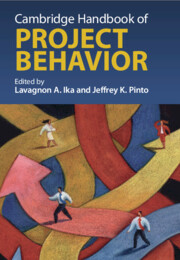Book contents
- Cambridge Handbook of Project Behavior
- Cambridge Handbook of Project Behavior
- Copyright page
- Contents
- Figures
- Tables
- Contributors
- Introduction
- Part I Guiding Principles
- Chapter 1 The Rise and Fall of the Planning Fallacy
- Chapter 2 Unveiling the Hiding Hand
- Chapter 3 Voyages of Discovery
- Chapter 4 Temporal Structuring and Project Behavior
- Chapter 5 Managing Project Complexity and Uncertainty through Dynamic and Systemic Stakeholder Modeling
- Part II Deviating from Plans
- Part III Practical Tips
- Index
- References
Chapter 3 - Voyages of Discovery
Balancing Leadership, Control, and Capabilities in Megaproject Delivery
from Part I - Guiding Principles
Published online by Cambridge University Press: 22 November 2025
- Cambridge Handbook of Project Behavior
- Cambridge Handbook of Project Behavior
- Copyright page
- Contents
- Figures
- Tables
- Contributors
- Introduction
- Part I Guiding Principles
- Chapter 1 The Rise and Fall of the Planning Fallacy
- Chapter 2 Unveiling the Hiding Hand
- Chapter 3 Voyages of Discovery
- Chapter 4 Temporal Structuring and Project Behavior
- Chapter 5 Managing Project Complexity and Uncertainty through Dynamic and Systemic Stakeholder Modeling
- Part II Deviating from Plans
- Part III Practical Tips
- Index
- References
Summary
Over the last decade there have been significant advances in our understanding of how delivery models enable megaproject innovation. Despite this, megaprojects often misbehave and struggle to take advantage of opportunities to innovate because control and leadership practices crowd it out. In this chapter we return to Albert Hirschman and his Voyage of Discovery principle and Latitude concept of project governance. Hirschman was a major proponent of innovation and observed the importance of a spirit of enterprise during the execution of large development projects. However, he did not elaborate on how the capacity to innovate might be mobilized in specific project contexts. This chapter extends these ideas by examining the literature on megaproject capabilities and the delivery model architectures that enable innovation during megaproject execution. We then examine the literature on the complementary roles that megaproject control and leadership can play in balancing and driving innovative responses to complexity and uncertainty. We conclude that there is a need for further research in this area.
Information
- Type
- Chapter
- Information
- Cambridge Handbook of Project Behavior , pp. 58 - 70Publisher: Cambridge University PressPrint publication year: 2025
References
Accessibility standard: WCAG 2.0 A
Why this information is here
This section outlines the accessibility features of this content - including support for screen readers, full keyboard navigation and high-contrast display options. This may not be relevant for you.Accessibility Information
Content Navigation
Allows you to navigate directly to chapters, sections, or non‐text items through a linked table of contents, reducing the need for extensive scrolling.
Provides an interactive index, letting you go straight to where a term or subject appears in the text without manual searching.
Reading Order & Textual Equivalents
You will encounter all content (including footnotes, captions, etc.) in a clear, sequential flow, making it easier to follow with assistive tools like screen readers.
You get concise descriptions (for images, charts, or media clips), ensuring you do not miss crucial information when visual or audio elements are not accessible.
You get more than just short alt text: you have comprehensive text equivalents, transcripts, captions, or audio descriptions for substantial non‐text content, which is especially helpful for complex visuals or multimedia.
You can access graphs or charts in a text or tabular format, so you are not excluded if you cannot process visual displays.
Visual Accessibility
You will still understand key ideas or prompts without relying solely on colour, which is especially helpful if you have colour vision deficiencies.
You benefit from high‐contrast text, which improves legibility if you have low vision or if you are reading in less‐than‐ideal lighting conditions.
